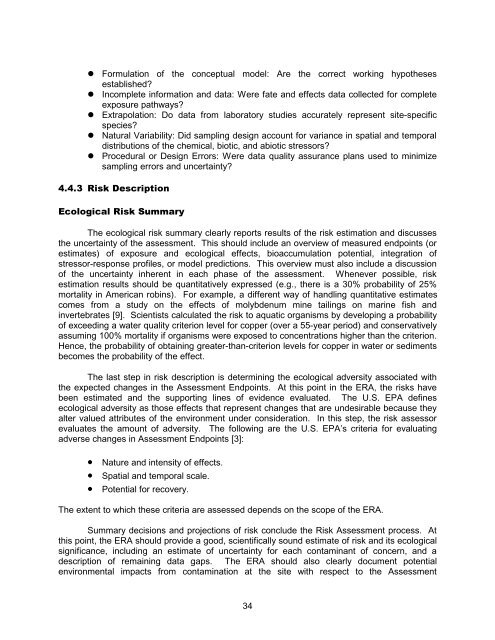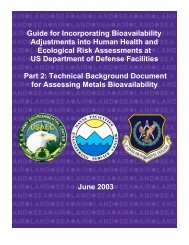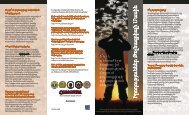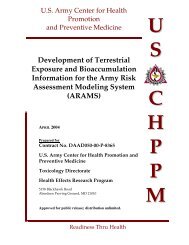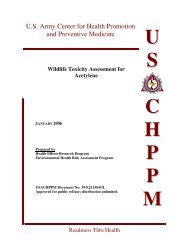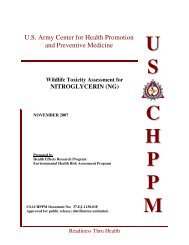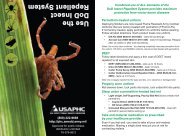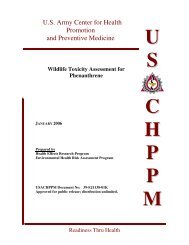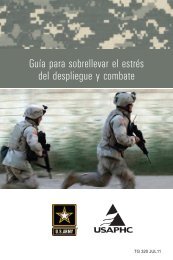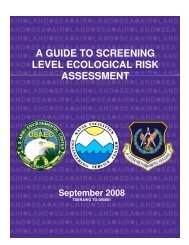Tri-Service Remedial Project Manager's Guide for Ecological Risk ...
Tri-Service Remedial Project Manager's Guide for Ecological Risk ...
Tri-Service Remedial Project Manager's Guide for Ecological Risk ...
Create successful ePaper yourself
Turn your PDF publications into a flip-book with our unique Google optimized e-Paper software.
l Formulation of the conceptual model: Are the correct working hypothesesestablished?l Incomplete in<strong>for</strong>mation and data: Were fate and effects data collected <strong>for</strong> completeexposure pathways?l Extrapolation: Do data from laboratory studies accurately represent site-specificspecies?l Natural Variability: Did sampling design account <strong>for</strong> variance in spatial and temporaldistributions of the chemical, biotic, and abiotic stressors?l Procedural or Design Errors: Were data quality assurance plans used to minimizesampling errors and uncertainty? 5LVN'HVFULSWLRQ(FRORJLFDO5LVN6XPPDU\The ecological risk summary clearly reports results of the risk estimation and discussesthe uncertainty of the assessment. This should include an overview of measured endpoints (orestimates) of exposure and ecological effects, bioaccumulation potential, integration ofstressor-response profiles, or model predictions. This overview must also include a discussionof the uncertainty inherent in each phase of the assessment. Whenever possible, riskestimation results should be quantitatively expressed (e.g., there is a 30% probability of 25%mortality in American robins). For example, a different way of handling quantitative estimatescomes from a study on the effects of molybdenum mine tailings on marine fish andinvertebrates [9]. Scientists calculated the risk to aquatic organisms by developing a probabilityof exceeding a water quality criterion level <strong>for</strong> copper (over a 55-year period) and conservativelyassuming 100% mortality if organisms were exposed to concentrations higher than the criterion.Hence, the probability of obtaining greater-than-criterion levels <strong>for</strong> copper in water or sedimentsbecomes the probability of the effect.The last step in risk description is determining the ecological adversity associated withthe expected changes in the Assessment Endpoints. At this point in the ERA, the risks havebeen estimated and the supporting lines of evidence evaluated. The U.S. EPA definesecological adversity as those effects that represent changes that are undesirable because theyalter valued attributes of the environment under consideration. In this step, the risk assessorevaluates the amount of adversity. The following are the U.S. EPA’s criteria <strong>for</strong> evaluatingadverse changes in Assessment Endpoints [3]:• Nature and intensity of effects.• Spatial and temporal scale.• Potential <strong>for</strong> recovery.The extent to which these criteria are assessed depends on the scope of the ERA.Summary decisions and projections of risk conclude the <strong>Risk</strong> Assessment process. Atthis point, the ERA should provide a good, scientifically sound estimate of risk and its ecologicalsignificance, including an estimate of uncertainty <strong>for</strong> each contaminant of concern, and adescription of remaining data gaps. The ERA should also clearly document potentialenvironmental impacts from contamination at the site with respect to the Assessment34


